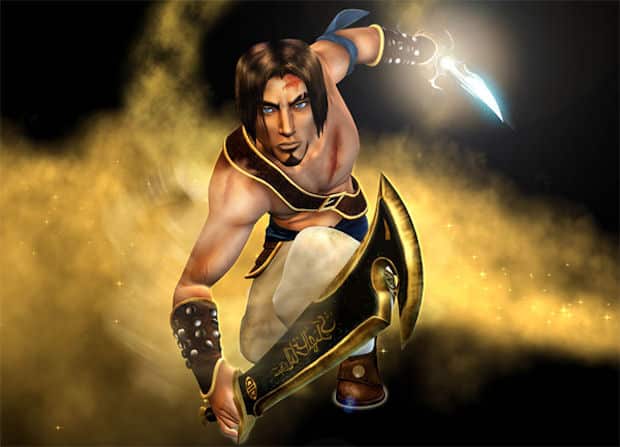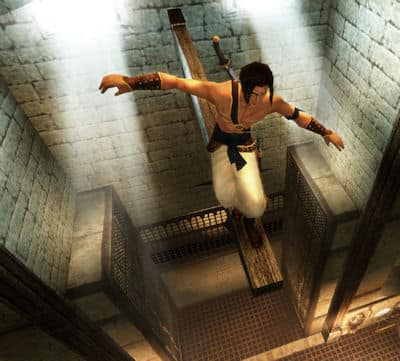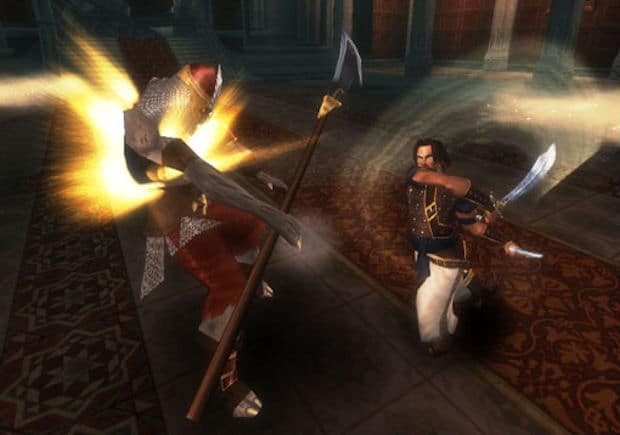
The Prince of Persia franchise has always been significant for reasons that transcend the video game medium. The original Jordan Mechner platformer released 20 years ago marks the first time the classic Middle-Eastern theme intersected with video games to popular acclaim. Beginning as folk tales, such stories were scribed to paper and eventually translated into novels before being exported to the west. These original novels inspired other writers to utilize the culturally rich palette of themes in their own story telling. As media evolved, the elusive subject matter followed suit and found its way on cinema screens with adaptions in Arabian Nights (1942), Ali Baba and the Forty Thieves (1944) and The Seventh Voyage of Sinbad (1958). The original Prince of Persia (1989), alongside Disney’s Aladdin and countless recent Hollywood adaptions represent the contemporary iterations of these classic tales which have crossed hands, eyes and ears since the 9th century.
As with the other western adaptions, Prince of Persia isn’t particularly deep, but for the most part it renders Middle-Eastern culture in a respectful light and like the other media should be noted as such. It’s not very often that western films and video games portray the Middle-East in a savoury context, if at all.
Sands of Time is arguably the franchise’s strongest embodiment of this long-running trail of folk lore. For these reasons, Sands of Time is one of the more culturally significant video games produced in recent times. With that said, let’s start this review out by talking about how the game is important within its own medium.

System: PlayStation 2, GameCube, Xbox, and Microsoft Windows PC
Genre: Adventure, Platforming
Release date: November 6, 2003
Players: 1
Developer: Ubisoft Montreal
Publisher: Ubisoft
Origin: Canada
The Sands of Time was critically successful back in 2003. Much of this acclaim can be attributed to the successful reimagining of the series’ core qualities. For those who enjoyed the original 2D games, Sands of Time is thoroughly nostalgic in its transformation of series ideals to a 3D playing space. Even if one lacks this history (assuming you don’t buy into the fantastic Prince of Persia Classic on Playstation Network and Xbox Live Arcade) Sands of Time is instantly likable and quickly draws you in.
“In this world there is only one rule: Master the sand or be buried.”
Sands of Time can be broken into three essential elements; platforming, combat and narrative. The game compartmentalizes each of these components nicely, keeping a gap between them while allowing them to bleed into each other slightly. Meaning combat will never disrupt the flow of parkouring through the environment yet light narrative can overlay gameplay in an effective but non-intrusive manner.
Platforming predominates the larger part of the game and rightly so. Unlike Metroidvania platformers, the protagonist’s full move set is available from the beginning. The Prince’s acrobatics are limited to a handful of basic manoeuvres that allow the Prince to scamper along walls, jump, hold onto ledges, wall jump, scale poles and leap from object to object – the necessities. Each of these moves are well mapped to the pad and feel tactile and responsive to the on screen avatar.

When the player enters a situation which requires acrobatics, they must tune into their surroundings by searching for any protruding elements which might provide a starting point. The player must be actively aware of the environment to proceed through the game – they are seeking out the personality traits that define the landscape and utilizing them for their own means. Its this constant reliance on the environment which permit the player to become encompassed in the narrative of this landscape.
The designers provide a visual language to scaffold this relationship. The first technique is through intuitive design. The landscape is visually indicative of where the hot spots are located – they drawn you into them. So long as you trust the flow of the environment’s aesthetic you will find the next marker and be rewarded for it. The colour, lighting and modeling all provide the clues. They also act to conceal secrets such as sand clouds that add to your sand tanks which we’ll get to later.

The second technique is the use of camera. The camera is most dynamic when it’s needed; while the Prince is navigating the environment, positioning itself to reveal the next crucial surface. This is important as sometimes the landscape wears away, demanding the player reach the next point of safety as quickly as possible before they fall to their doom. When there isn’t a sense of urgency, the player is usually on solid ground where the camera provides less assistance, forcing you to rely on your own senses as previously described. Fortunately the player is clued into future points of interest at every save point where the Prince will hallucinate himself completing the more trickier parts of forthcoming challenges.
The hallucinations tie into Sands of Time’s key theme – time. The sands, along with the Prince’s dagger allow him to slow and rewind time – handy if you find yourself caught in a fix. Sands of Time never requires the use of slowing down time to solve the puzzles, so I rarely if ever considered using it. Rewinding time on the other hand is overtly useful in a game where fatal mistakes are a common occurrence. These sequences of time manipulation were spectacular for the day and have since become an industry standard.
“Deceived by the treacherous Vizier, I was led to unleash the Sands of Time curse upon the Sultan’s kingdom. With little but an ancient dagger and a devious princess to aid me, I must undo my fatal mistake. Mine is a fight for survival… not glory.” -The Prince
The Prince himself is defined by his inabilities more so than his abilities. Leaping about palaces is clearly a tiresome occupation and the Prince expresses his exhaustion well through the voice overs which run over the top of gameplay. He and the female protagonist, Farah, often exchange dialogue in game creating a seamless bond between the two. She’ll gasp and voice concern over the Prince’s dangerous feats, creating an affinity between her and the player. It’s not very often that video games respond dynamically to our actions in such a personal manner. While a very simple technique, the interplay between characters personalizes the narrative and makes it relevant to the player (she is concerned about what you’re doing after all).
The banter exchanged between the two characters begins as bickering and slowly transforms into affectionate dialogue as the two form a kinship through their travels. This is the crux of Sands of Time’s narrative: the tale of a boy becoming a man. The reasons why the narrative has seen such critical acclaim in some circles is because of the way it unfolds naturally in game, more importantly though the narrative is implied rather than it is told outright. With video games cramming lame narratives down player’s throats, Prince of Persia succeeds because of its modesty. The tale is a simple one, but underneath the pretense is a story of a boy becoming a man and it’s refreshing to be delivered in such a manner.

Combat is the weakest part of the game but isn’t a huge detriment to the overall quality. As mentioned previously, the combat is separated nicely from the platforming. You’ll often enter a room, joust with the local zombies and then begin the platforming portion of the area. It’s awkward trying to circumvent this and skip straight to the platforming as the enemies become an overwhelming distraction. The order of events makes combat feel like a less-enjoyable entree to the immensely satisfying platforming. The game obviously needed a combat bit and you’ll be forced through the motions.
The combat while a little unwieldy compared to more fluent combat systems such as the one in God of War, isn’t by any means terrible, it just grates compared to the sublime finesse of the platforming. The Prince can strafe around enemies, vault over them for a back attack, lunge off walls and counter attack. The basic attacks are fairly conventional. Defeating enemies with a final coup de grâce with the dagger will refill your sand tanks which act as tally used to slow and rewind time, just as with the rest of the game. The sand tanks also allow the Prince to freeze enemies and launch into a ‘mega freeze’ which can destroy hoards of enemies quickly. As with the rest of the combat, the enemies are standard fair, it all amounts to a passable bit of variety from the platforming. They would have been better off to scrap it, would have made the game appear pacifist and less submissive to the demands of the culture of this industry.
Watch the Prince of Persia: The Sands of Time theatrical trailer:
CONCLUSION:
While the original concept for Prince of Persia was inspired by traditional Middle-Eastern tales, the video games have birthed a legacy of their own. Following the time line, it’s easy to see the tremendous mark that the original game and its chronology has had on this stream of the adventure genre. Prince of Persia set the benchmark for smooth, well animated platforming, The Sands of Time returns to this base and revives it with new found vigor in 3D. Assassin’s Creed is the spiritual successor to the timeline which further ushered the original ideals of Jordan Mechner’s classic into the modern realm. Each of these titles captured the essence of free-running platforming and has maintained it in a timeless fashion. It’s for these reasons that Prince of Persia: The Sands of Time is worth playing all these years after release. Because it’s an integral piece of modern adventuring and holds its ground impeccably. Fans of Assassin’s Creed or the recent Infamous would surely enjoy playing through the origins of this genre. The original 2D game is on the disc too.

FUN FACTOR: 9
Well thought out platforming where the landscape acts as one giant puzzle. Combat is alright too. Overall the platfoming elements become irresistibly addictive, the game’s crux.
Graphics: 9
Nice use of illuminating effects and dust which aid in creating a whimsical atmosphere. Colour is rich and the design authentic and interesting.
Audio: 9
Wonderfully suited to the overarching atmosphere of the title. Voice work is great too.
Ingenuity: 9
Sands of Time set the standards for many innovative mechanics such as time manipulation and fluid acrobatics in a 3D space. While these are now commonplace, the game trumps many in its clever implementation of ideas.
Replay Value: 9
Originally criticized for its short length, Sands of Time was caught up in the era when we evangelized the 60 hour game. Truth is, the 10-20 hour length is just fine and doesn’t feel the least bit exhaustive.
